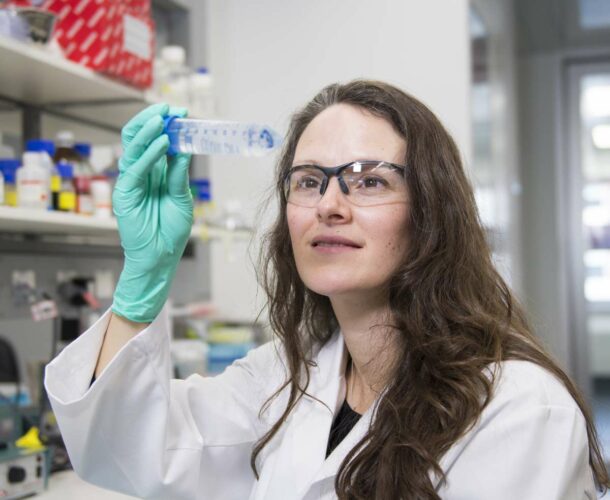A research team led by Associate Professor Marnie Blewitt, Dr James Murphy and Ms Kelan Chen from the Walter and Eliza Hall Institute investigated the gene Smchd1, which is dysfunctional in people with facioscapulohumeral muscular dystrophy (FSHD). It is a progressive wasting disease that it is rarely fatal but very debilitating. The disease is inherited from the child’s parents and no treatments or cures are currently available.
Marnie Blewitt: satisfying childhood curiosity
It began with a little girl curious to know how her body was made. At primary school she heard of cells, and she would study her hand, wondering of each small part, “Is that a cell? How big are they? How many are there?”
The little girl grew up to be a young scientist who designed her PhD project to satisfy that curiosity. The result: Dr Marnie Blewitt was only 27 when she discovered a ‘new’ gene, as yet unmapped and un-named, the kind of triumph that is as big in her field of biology as discovering a new star would be for an astronomer. Her follow-up work has helped uncover genetic causes in mice of problems including late miscarriage and muscular dystrophy.
“I didn’t imagine that in my lifetime, I would see my discoveries being used in medicine down the track,” Blewitt says. “Now, I am becoming convinced that they could be. Then my discovery would have gone from the bench, basic science, to the bedside.”
Blewitt is now a laboratory head and faculty member at the Walter and Eliza Hall Institute. Her field is the study of epigenetics, markers that tell the genes how to work, and when to switch on or off.
“We have around 20,000 genes in our genome, but each cell won’t use all of those 20,000 genes,” Blewitt says. “Only a subset gets chosen for each cell type. You need to express haemoglobin in red blood cells, and myelin in cells in the brain, for example.”
DNA ‘punctuation’ marks
Epigenetic markers are placed on a DNA sequence like punctuation marks in books, she explains. “A capital letter lets you know it is the beginning of a sentence; the full stop is at the end; an exclamation mark changes your reading of the sentence. You can have an epigenetic ‘exclamation mark’ that says, ‘Use this gene now!’ It could be that a specific keratin gene is switched on for your hair but in, say, your eyes, that sentence might have a full stop at the end, saying ‘You don’t need keratin here.’”
The new gene she discovered – formally named SMCHD1, but affectionately known to its intimates as “Smooch” – turned out to be involved in many aspects of epigenetic control. Most importantly, it helps to “silence” the second X chromosome in females.
Males have one X and one Y chromosome; females have two Xs, but one of them must be inactivated, Blewitt says. “If they are both left unchecked, there would be double the dose of the thousand or so genes on the X chromosome.
“Embryos that lack Smooch can’t keep the second X inactivated. If that happens, it results in embryos dying from placental insufficiency. Girls die in utero. This happens just before mid-gestation; it’s not an early pregnancy loss.”
Hope for untreatable disease
Smooch also turned out to be involved in one form of muscular dystrophy “if people have this mutation and another in the genome”.
Blewitt is hoping that treatments for this form of muscular dystrophy might lie in her team’s work. “We might be able to help these patients. These patients always have one good copy of the gene, so maybe we can make it work better or harder to make up for the bad copy, or boost the amount of Smooch that’s available.”
Meanwhile, her lab is also searching for other epigenetic markers important in higher mammals. The freedom to pursue her fascination, and follow up her initial big discovery, is a big part of what she loves about working for the Walter and Eliza Hall Institute.
Blewitt won the L’Oréal Australian Women in Science Fellowship and a Dyson Bequest Fellowship to help her continue her work. She had several international offers of work following her discovery of Smooch but came to the Walter and Eliza Hall Institute because its current director, Doug Hilton, promised that she could work in epigenetics. “The key thing is that he wanted me to be independent from the start.
“That was better than Oxford, Cambridge, or University College London for me. I was very, very lucky. As a scientist, you can’t get any better than to be allowed to work on what you want.”




